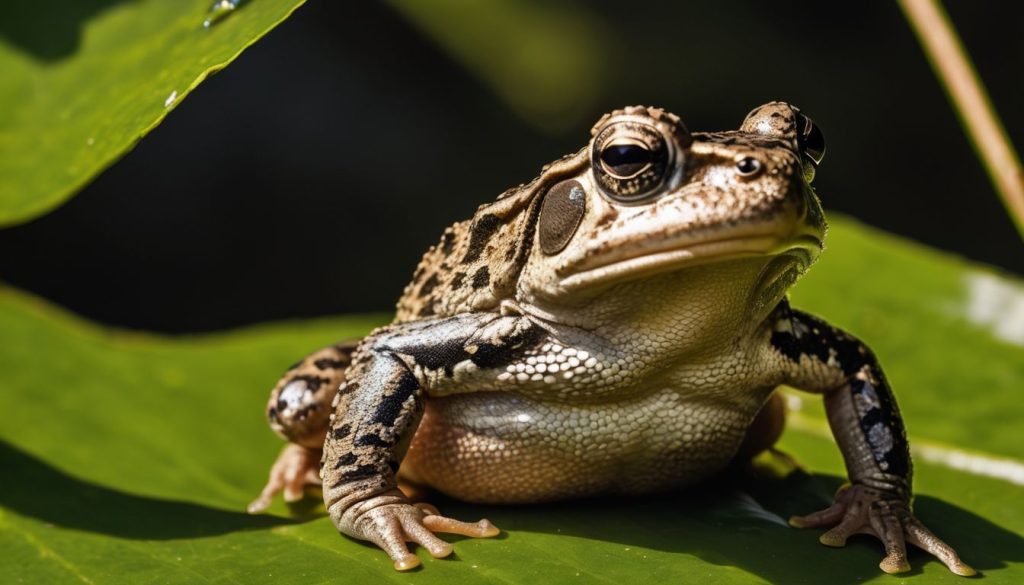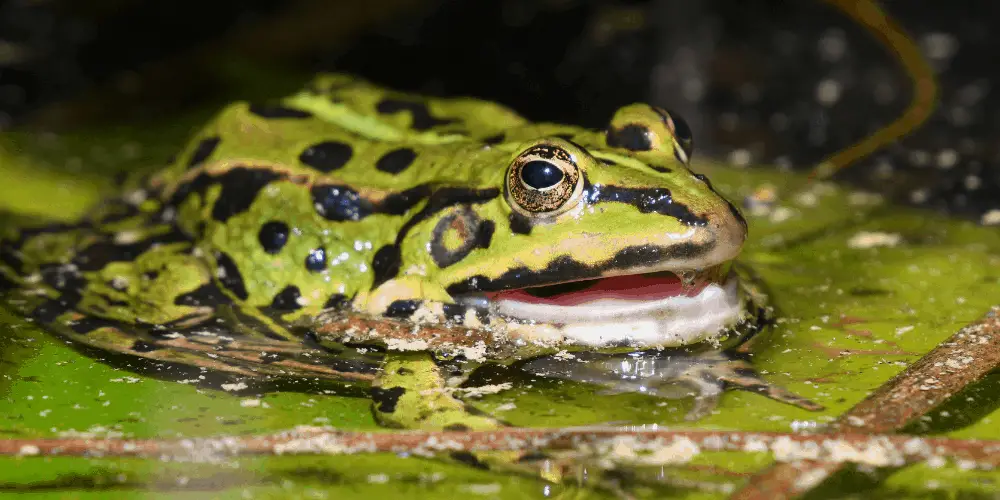Have you ever wondered why some people call them frogs while others swear they’re toads?
It’s a common mix-up since all toads are a kind of frog!
Our article is here to hop into the specifics, pinpointing exactly how these two amphibian family members differ, from their bumpy skins to their favorite habitats.
Keep reading and prepare to leap into a world of fascinating facts that will clear up any toad vs frog differences confusion for good!
Key Takeaways
Toads can be distinguished from frogs by their rough, dry skin and short hind legs, while frogs typically have smooth, moist skin and longer hind legs.
Their body shapes and sizes also differ, with toads having broader bodies and shorter legs compared to the sleeker build of frogs.
Skin Texture
Frogs boast smooth, moist skin that glistens in aquatic or damp environments. This sleek coating helps them quickly slip through the water and contributes to gas exchange, vital for survival.
On the other hand, toads present a contrasting appearance with dry, bumpy skin featuring warts and ridges.
These textures aren’t just for show; they offer camouflage among leaves and dirt in their more terrestrial habitats.
The rough exterior of a toad’s skin secretes a substance that can poison predators when touched or ingested.
Equipped with parotoid glands behind their eyes, they produce toxins as a defense mechanism against threats—a feature absent in their frog cousins.
With these distinctive skins, each amphibian thrives in its niche within the diverse tapestry of nature’s design.
Body Shape and Size
Toads generally have a squatter and stockier body shape compared to frogs. Their bodies are somewhat dumpy in appearance, with shorter hind legs that limit their ability to leap and swim as efficiently as frogs can.
Frogs, on the other hand, are lithe and athletic-looking, with longer hind legs that allow them to leap far over the ground and swim swiftly through the water.
This difference in body shape and size affects their agility and preferred habitats.
Frogs’ long hind legs give them an advantage in leaping ability over toads, who tend to be less agile due to their stockier build.
Additionally, while frogs have a pointed nose and a leaner appearance, toads possess a different face structure with larger eyes relative to their body size.
Hind Leg Structure
Frogs have longer hind legs designed for leaping and swimming. The muscular hind limbs allow frogs to make impressive leaps over land and rapidly propel themselves through water.
Toads have shorter hind legs than frogs, limiting their jumping ability.
This key difference in leg structure influences the locomotion methods of these amphibians, with frogs being more agile and adept at covering distance both on land and in water.
Moving on to “Habitat Differences,” let’s explore how the preferred living environments of toads and frogs set them apart.
Habitat Differences
Toads generally prefer drier environments and can be found in open grasslands, while frogs favor moist habitats like swamps, marshes, and ponds.
Frogs are also more adept at climbing trees and are often found in tree-dwelling habitats.
Preference for Moisture
Toads and frogs have different habitat preferences. Toads favor drier environments, such as deserts, grasslands, and forests. They are often found in areas with less water, like gardens and backyards.
On the other hand, frogs typically prefer wetter habitats such as marshes, ponds, and swamps. These environments provide the moisture necessary for their skin to stay hydrated and allow them to lay eggs in water.
Both creatures play essential roles in their respective ecosystems by controlling insect populations through predation while supporting various food chains.
Ability to Climb Trees
Toads generally aren’t adept at climbing trees. They lack the physical adaptations that enable frogs to scale branches and leap from limb to limb.
Their shorter, less powerful hind legs make them better suited for hopping rather than climbing.
Frogs, on the other hand, possess long, muscular hind legs that allow them to jump great distances and clamber up trees with ease.
These differences in leg structure reflect the habitat preferences of each species: frogs typically favor tree-dwelling environments, while toads tend to be ground dwellers.
Frogs’ ability to climb trees is a critical feature that distinguishes them from their counterparts. Their powerful hind legs and gripping toe pads equip them for life in arboreal settings.
Preferred Living Environments
Toads and frogs have distinct preferences when it comes to their living environments. Toads favor drier habitats with less moisture, like deserts, grasslands, and forests.
On the other hand, frogs are typically found in wetter habitats like marshes, swamps, and tropical rainforests.
These differences in habitat preference reflect each animal’s adaptation to specific environmental conditions.
Frogs tend to gravitate toward aquatic environments due to their need for moisture, essential for skin function and reproduction.
This contrasts with toads’ ability to thrive in relatively drier settings, where they have adapted specialized skin structures that enable them to retain water more efficiently.
Behavioral Differences
Toads prefer to walk or hop, while frogs are excellent jumpers. Keep reading to learn more about the fascinating behavioral differences between toads and frogs!
Locomotion Methods
Toads move by walking or taking short hops, as they have shorter hind legs than frogs. They rely on their powerful front legs and tend to move more leisurely.
Frogs, on the other hand, are renowned for their jumping ability due to their longer hind legs, which enable them to leap great distances swiftly.
They also use swimming as a mode of transportation, utilizing webbed feet for efficient movement through water.
Frogs propel themselves forward with strong leg muscles and agile leaps while hopping or swimming. Toads prefer slower movements using their front limbs and shorter hops due to their less developed hind legs.
Communication Methods
Toads and frogs communicate using various methods, including vocalizations, body language, and chemical signals.
Frogs produce sounds by inflating their vocal sacs and vibrating their larynx to create distinctive calls like “ribbit” or “croak,” which attract mates and defend territories.
Toads also use vocalizations but have more resounding calls that may sound more like a trill.
Furthermore, both species use physical postures to convey messages — for example, puffing themselves up when threatened.
Moreover, they release chemical cues through glandular secretions on their skin.
Defensive Mechanisms
Toads employ defensive mechanisms as a means of protection from predators.
Their skin secretes toxins, which can be harmful or fatal to animals that attempt to ingest them. Some toad species have brightly colored patterns, a warning sign of their toxicity.
Additionally, when threatened, some toads puff themselves up to appear larger and more daunting, while others emit a loud, high-pitched trill or squeal to ward off potential threats.
Frogs also utilize defensive tactics for survival. Certain frog species have developed camouflage abilities, enabling them to blend in with their surroundings and avoid predator detection.
Life Cycle Differences
Toads and frogs have distinct differences in their egg-laying process, development stages, and adult reproductive behaviors.
Understanding these differences can provide valuable insights into the unique life cycles of these amphibians.
Egg-laying Process
Toads and frogs have different egg-laying processes. Female toads usually lay eggs in long, stringy chains, with the eggs enclosed in a protective jelly-like substance. These are often laid in quiet water bodies like ponds or lakes.
Conversely, female frogs lay their eggs in clusters or masses floating on the water’s surface, found in moist environments such as marshes and swamps.
The toads’ and frogs’ offspring develop from these eggs into tadpoles before undergoing metamorphosis into adult amphibians.
Development Stages
After the egg-laying process, the development stages of toads and frogs vary significantly. Once hatched, tadpoles emerge from frog eggs, while toad eggs produce tiny toadlets directly.
Tadpoles undergo metamorphosis, transforming into frogs with long hind legs meant for leaping and swimming.
Toadlets develop limbs and lose their tails as they transition into ground-dwelling creatures.
The development stages showcase the distinct life cycle processes of these amphibians.
Frogs lay clusters of eggs in water, whereas toads typically lay long chains of eggs on land or in shallow water.
Tadpoles develop gills that later disappear during metamorphosis, evolving into adult frogs capable of living in water and land.
Adult Reproductive Behaviors
Frogs lay their eggs in large clusters, while toads often deposit theirs in long chains.
Males of both species make a call to attract females during mating season. Toads mate on land or near the water’s edge, while frogs often reproduce in shallow water.
Both amphibians prefer quiet ponds or slow-moving streams for breeding purposes.
Moving on to “Key Similarities between Toads and Frogs”, let’s explore their shared characteristics and importance to the ecosystem.
Key Similarities between Toads and Frogs
Despite the differences, toads and frogs are both classified as members of the order Anura. They share many physical and behavioral characteristics and play essential roles in their ecosystems.
Amphibian Classification
Toads and frogs are members of the order Anura, which classifies them as amphibians. They share similar characteristics, including moist skin and a dual lifestyle.
Toads and frogs play an essential role in the ecosystem as ground-dwelling animals that contribute to insect control and serve as prey for other animals, such as reptiles.
Both toads and frogs possess specialized vocal cords that emit distinct sounds like croaks or ribbits, enabling communication with others of their kind.
These amphibians are crucial classroom pets because they allow students to observe animal families up close while learning about their unique adaptations.
Understanding the classification of these creatures is essential for appreciating their significance within various ecosystems.
Shared Characteristics
Toads and frogs may have unique differences but share specific key characteristics.
Both belong to the order Anura, making them types of amphibians that spend part of their lives in water and on land.
Additionally, both species play crucial roles in maintaining balanced ecosystems by controlling insect populations and serving as a food source for other animals.
Despite their differences in habitat preference, both toads and frogs contribute to the environment’s overall health.
Furthermore, these ground-dwelling and tree-dwelling animals are crucial to their habitats, emphasizing preserving diverse environments.
Despite being poisonous amphibians, both species exhibit fascinating biological adaptations that allow them to survive within their chosen ecosystems.
Importance to the Ecosystem
Toads and frogs are critical in the ecosystem as predators and prey. Their diet includes insects, spiders, worms, and other small creatures, helping to control pest populations in their habitats.
As they hunt for food, they contribute to the balance of local ecosystems by preventing certain species from overpopulating.
Additionally, as prey for birds, reptiles, and mammals, toads and frogs are essential components of food chains within their habitats.
Their reproductive behavior also influences the ecosystem through egg-laying processes and tadpole development stages in water bodies such as ponds or wetlands.
Tadpoles serve as a substantial source of nutrition for various aquatic organisms.
Conclusion
In conclusion, frogs and toads have distinct physical differences. Their habitat preferences also vary significantly.
Frogs are known for their agile movements and vocal communication, whereas toads rely on different locomotion methods and defensive mechanisms.
The differences in their life cycles further set them apart as unique species within the amphibian classification.
FAQs
Do frogs and toads get along?
Frogs and toads can coexist in the same environment but generally do not interact closely due to different habitats and behaviors. They tend to live independently of each other.
Can toads breathe underwater?
Toads cannot breathe underwater as they breathe through their skin and lungs. They need to come to the surface to get air, although they can stay submerged for extended periods.
Do toads walk or hop but frogs?
Toads typically walk or take short hops due to their shorter hind legs, while frogs are known for their ability to leap and swim efficiently, thanks to their longer hind legs.
Can toads climb trees?
Toads cannot climb trees because they lack physical adaptations, such as sticky toe pads and long, powerful hind legs, that allow frogs to climb and leap between branches effectively.




